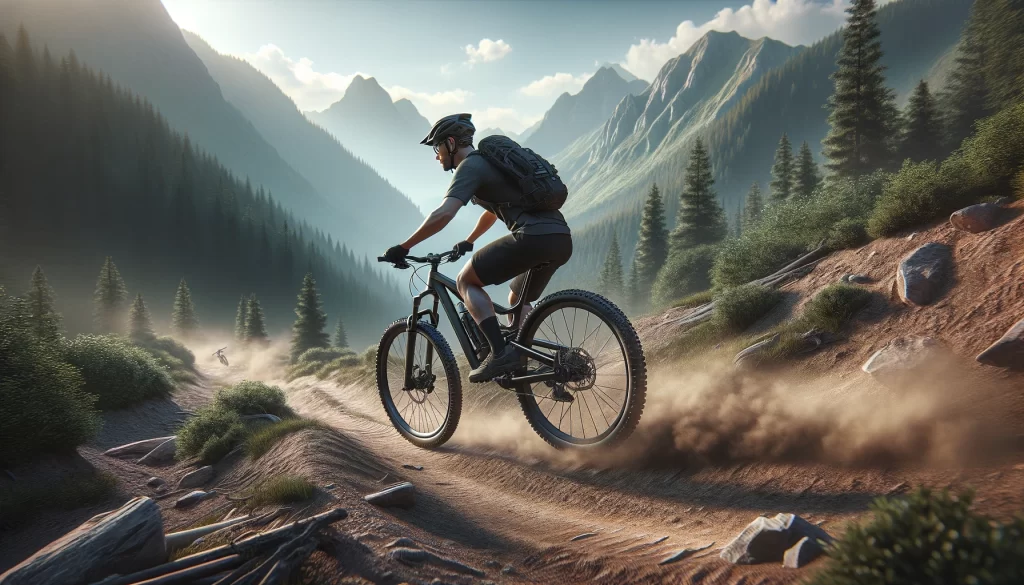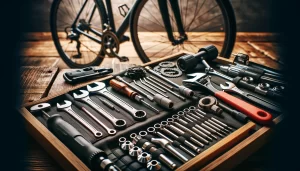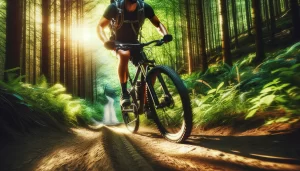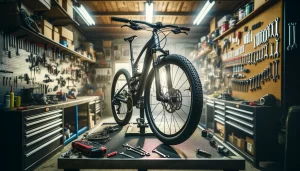Maintenance bike enthusiasts know that the right tires are not just a component of your bicycle—they are the foundation of your riding experience. Selecting and installing the proper tires for your bike ensures you get the best performance, safety, and comfort on any terrain, whether it’s the smooth asphalt of city roads or the rugged paths of mountain trails.
This guide is designed to demystify the process of choosing the right bicycle tires, providing you with essential knowledge to make informed decisions tailored to your specific riding needs. Embarking on this journey, you’ll discover how different tire designs can enhance your cycling, affecting everything from speed to traction.
We’ll explore the nuances of tire width, tread patterns, and material compositions, and how each of these factors should be considered based on the landscapes you traverse. Our goal is to equip you with the confidence to select and install tires that will transform your biking experience, ensuring each ride is smoother, safer, and more enjoyable. Continue reading to find out how to elevate your cycling adventures through the simple, yet critical choice of your bike’s tires.

Image Source: Image Generated With DALL-E on ChatGPT
Understanding the Importance of Proper Tires for Each Terrain
Proper tires are crucial for safe and efficient biking across different terrains. Each type of terrain demands specific tire characteristics to optimize grip, comfort, and durability. For instance, smooth tarmac requires narrow, high-pressure tires for speed, whereas rocky trails need wider tires with aggressive treads for stability.
Choosing the right tire enhances handling, reduces fatigue, and prevents accidents, making it essential for any cyclist to understand their options based on their usual riding environments.
Steps to Choose the Right Tires for Your Terrain:
- Identify Your Main Riding Terrain: Determine whether you primarily ride on streets, trails, or mixed surfaces.
- Research Tire Characteristics: Look for tires with traits suited to your terrain (e.g., tread, width, rubber compound).
- Consult with Local Cyclists: Ask more experienced local riders or bike shop staff for recommendations.
- Test Different Tires: If possible, try out different tires to feel their impact on your ride.
- Regularly Evaluate Tire Condition: Inspect your tires for wear and adapt your choice as your riding style or terrain changes.
Types of Bicycle Tires for Mountain or Dirt Trails
Mountain biking and riding on dirt trails require tires that can handle rough and loose surfaces effectively. These tires are typically wider with deep, aggressive treads that provide the necessary traction and stability on uneven ground.
The rubber compounds are also tougher to resist punctures and abrasions from rocks and roots. Understanding the variations among mountain bike tires can significantly improve a rider’s control and safety on challenging terrains.
Suggestions for Choosing Mountain Bike Tires:
- Width Matters: Opt for wider tires (2.1 inches or more) to improve stability and grip.
- Tread Pattern is Key: Choose deep, aggressive treads for better traction in mud and loose dirt.
- Consider Tubeless: Consider tubeless tires for better puncture resistance and the ability to run lower pressures.
- Adjust Tire Pressure: Experiment with different tire pressures to find the optimal balance between traction and efficiency.
- Inspect and Replace: Regularly check your tires for signs of wear and replace them before they fail.
Urban Bicycle Tires: What You Need to Know
Urban bicycle tires are designed to provide comfort, durability, and performance in city environments. These tires often feature a balance between smooth-rolling efficiency and puncture resistance to handle the variety of surfaces found in urban settings, from smooth pavement to cobblestones and occasional debris.
Additionally, urban tires may come with reflective sidewalls for increased visibility. Choosing the right urban tire can greatly enhance your riding experience in the city by reducing maintenance issues and improving ride quality.
Steps to Select Urban Bicycle Tires:
- Assess the Urban Environment: Consider the typical road conditions you encounter (e.g., potholes, debris).
- Look for Puncture Resistance: Choose tires with reinforced layers or puncture-resistant technology.
- Opt for Comfort: Wider tires (around 28mm to 32mm) can offer more comfort on uneven surfaces.
- Check for Additional Features: Reflective sidewalls and dynamic tread patterns enhance safety and grip.
- Consult Reviews and Local Shops: Get advice based on local rider experiences and expert recommendations.
Best Tires for Road Cycling
The best road cycling tires combine low rolling resistance, lightweight construction, and sufficient puncture protection. These tires are usually narrow (commonly around 23mm to 28mm) which helps in achieving high speeds.
Advances in tire technology have led to variations like tubeless and puncture-resistant models, offering road cyclists options tailored to their specific needs, whether racing or long-distance rides. Selecting the right road tire can significantly affect your speed, comfort, and overall performance on the road.
Tips for Choosing the Best Road Cycling Tires:
- Prioritize Rolling Resistance and Weight: Look for lightweight tires with low rolling resistance for better speed and efficiency.
- Consider Width and Comfort: Wider tires might offer more comfort without a significant speed penalty.
- Explore Tubeless Options: Tubeless tires can provide better puncture protection and allow for lower tire pressures.
- Evaluate Tread and Conditions: For wet conditions, tires with better grip and suitable tread patterns are crucial.
- Regular Maintenance: Regularly check and maintain tire pressure and tread condition to ensure optimal performance.
Adjusting Tire Pressure for Different Riding Conditions
Adjusting the tire pressure according to the riding conditions is a critical step for optimizing performance and comfort on a bicycle. Lower pressures typically offer better traction and a smoother ride on rough or slippery surfaces by allowing the tire to conform more to the terrain. Conversely, higher pressures are suitable for smooth, hard surfaces such as asphalt because they decrease the rolling resistance and increase speed.
Cyclists need to consider factors such as weather conditions, terrain roughness, and their weight when determining the ideal tire pressure. It’s a balancing act between achieving enough firmness to prevent rim damage and flats, and maintaining enough softness to handle bumps and technical terrain efficiently.
For example, when transitioning from a paved road to a gravel trail, a rider might reduce their tire pressure to gain better grip and control on the looser surface. This adjustment can prevent the tires from bouncing on the terrain, which improves bike handling and reduces rider fatigue.
Conversely, before a long stretch of city riding on smooth asphalt, inflating the tires to near maximum recommended pressure could enhance speed and efficiency. Keeping a portable pump or CO2 inflator handy allows cyclists to make these adjustments on-the-go, adapting to changes in riding conditions to maintain optimal performance and safety.

Image Source: Image Generated With DALL-E on ChatGPT
Preventive Tire Maintenance for Long-Distance Cycling
Preventive maintenance of bicycle tires is essential for ensuring reliability and safety, especially when preparing for long-distance rides. This type of maintenance involves regular inspections for wear and tear, timely replacement of tires, and checks for optimal tire pressure.
Worn-out tires are more susceptible to punctures and failures, which can be particularly inconvenient and dangerous on long rides far from repair shops. Cyclists should check for signs of tread wear, cuts, and embedded debris in the tires that could lead to punctures. Replacing tires before they fail can save a lot of trouble and enhance the cycling experience.
In addition to regular inspections, another key aspect of tire maintenance for long rides is ensuring the tires are appropriately suited for the expected conditions of the route. This includes choosing the right type of tires—whether for smooth tarmac, mixed-terrain, or rugged mountain trails—and ensuring they are in top condition before setting out.
Cyclists should also consider carrying a spare tube, a patch kit, and the tools necessary for roadside repairs. By taking these preventive steps, riders can minimize the risk of tire problems, thereby enhancing their long-distance cycling experience and maintaining high performance throughout the journey.
Frequently Asked Questions About Bicycle Tires
1. What is the best tire width for my bike?
- The ideal tire width depends on your type of riding. Narrower tires (23mm-25mm) are common for road cycling, offering speed and agility. Wider tires (28mm and above) are better for comfort and stability, suitable for gravel or urban cycling.
2. How often should I replace my bicycle tires?
- The lifespan of a tire depends on its use, material quality, and riding conditions. Typically, road bike tires should be replaced every 1,000 to 3,000 miles, while mountain bike tires might need replacement sooner due to rougher riding conditions.
3. Can I use tubeless tires on any bike?
- Tubeless tires can be used if your rims are tubeless-ready. This setup offers benefits like reduced flats and the ability to run lower pressures for better traction, but it requires compatible rims and a proper sealing setup.
4. How do I know if my tires are worn out?
- Check for signs like decreased tread depth, visible fabric or cords, frequent flats, or cracked rubber. These indicators suggest it’s time to replace your tires.
5. What pressure should I inflate my tires to?
- Tire pressure should be based on your weight, riding style, and conditions. Most tires list a recommended pressure range on the sidewall, and adjustments should be made within these limits based on specific needs.
6. Are wider tires slower than narrower ones?
- Contrary to common belief, wider tires can be as fast as narrower ones because they offer better rolling resistance on rough surfaces and can be run at lower pressures, which reduces fatigue and increases speed in some conditions.
Choosing the right tires for your bicycle can dramatically affect your riding experience and performance. Whether you are commuting, road racing, or trail riding, understanding the types of tires available, their intended uses, and how to maintain them will help you make the best choices for your cycling needs.
Regular maintenance and timely replacements will not only ensure optimal performance but also enhance safety on your rides. By paying attention to tire wear, pressure, and suitability for your typical routes, you can enjoy more efficient, comfortable, and reliable cycling, no matter where your journeys take you.
Did you like the article? Be sure to check out more content like this in the Maintenance Guide category or see more related content below.






